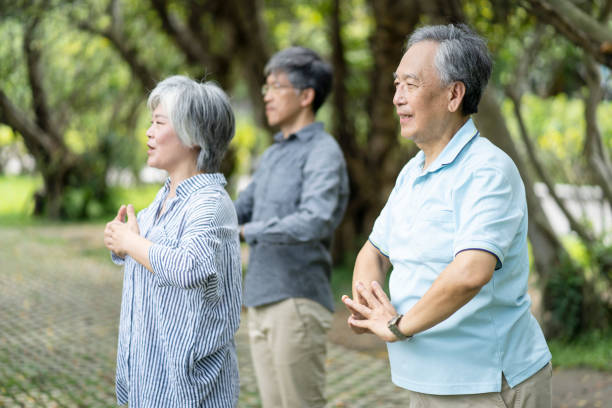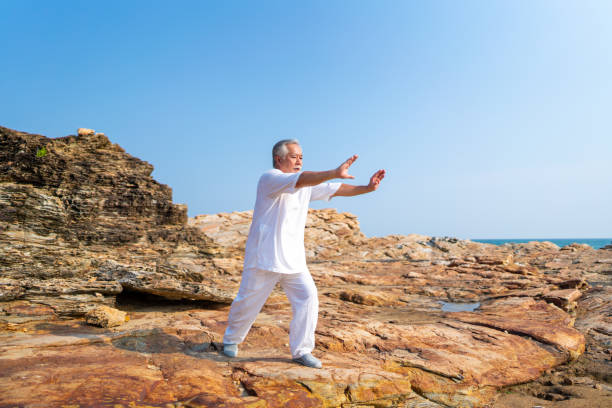Workouts
Tai Chi’s Impact on Osteoporosis and Your Well-being
Are you seeking for an activity that is both mild and effective for controlling osteoporosis? Look no farther than Tai Chi. This traditional Chinese technique includes slow, flowing motions, deep breathing, and meditation. Tai Chi is not just a low-impact exercise that is appropriate for people of all ages and fitness levels, but research indicates that it may also aid those with osteoporosis.
Understanding Osteoporosis
Millions of people worldwide suffer from osteoporosis, which is characterized by bone density loss and an increased risk of fractures. It is often linked to aging, hormonal changes, and a lack of calcium and vitamin D in the diet. The disorder weakens bones, leaving them more susceptible to fractures, especially in the hips, spine, and wrists.
Traditional aerobic and resistance activities can benefit bone health, but they may not be appropriate for everyone. High-impact activities such as sprinting and jumping can exert strain on the bones, increasing the risk of fractures. Tai Chi can help with osteoporosis by providing a moderate yet effective workout choice.

What is Tai Chi?
Tai Chi is an ancient Chinese martial technique that first appeared in the 12th century. It is commonly referred to as “moving meditation” due to its calm, graceful movements and focused concentration on the breath. Tai Chi forms, or movement sequences, are executed in a continuous, flowing way, which promotes relaxation and attention.
Tai Chi is founded on the concept of yin and yang, which represents the harmony of conflicting energies. It integrates elements of balance, flexibility, and alignment, making it an excellent exercise for improving both physical and mental health.
The Benefits of Tai Chi for Osteoporosis
According to studies, frequent Tai Chi practice can improve bone density, muscle strength, balance, and lower the chance of falling. Tai Chi is a helpful supplement to osteoporosis care due to its numerous benefits.
Scientific Research on Tai Chi and Osteoporosis
Numerous scientific research have looked into the impact of Tai Chi on bone health and osteoporosis. A systematic review and meta-analysis published in the Journal of Sports Sciences discovered that Tai Chi significantly enhanced bone mineral density in postmenopausal women. Another study, published in the Journal of Aging and Physical Activity, found that a 12-week Tai Chi program improved balance and reduced the incidence of falls in older persons with osteoporosis.
How Tai Chi Improves Balance and Reduces the Risk of Falls
One of the most important components of Tai Chi is its emphasis on balance and stability. Tai Chi’s slow and controlled movements help to improve body alignment and posture. This, in turn, lowers the chance of falls and fractures, both of which are serious concerns for people with osteoporosis.
Tai Chi also increases muscle strength, especially in the lower body. Strong muscles support the bones and assist maintain balance, lowering the chance of falling. Tai Chi also develops flexibility and joint mobility, which improves general physical function and reduces the risk of injury.

Tai Chi Exercises for Osteoporosis
There are various Tai Chi exercises that can be beneficial for individuals with osteoporosis. These exercises focus on improving balance, flexibility, and strength while minimizing the risk of injury. Some common Tai Chi exercises for osteoporosis include:
- Tai Chi Warm-Up: Start with gentle warm-up exercises like neck rotations, shoulder rolls, and ankle rotations to prepare the body for Tai Chi practice.
- Tai Chi Stance: Practice a stable and balanced stance by standing with feet shoulder-width apart, knees slightly bent, and weight evenly distributed between both legs.
- Tai Chi Movements: Perform Tai Chi forms or movements such as “Grasp the Sparrow’s Tail,” “Wave Hands Like Clouds,” and “Part the Wild Horse’s Mane.” These flowing movements help improve balance, coordination, and muscle strength.
- Tai Chi Qigong: Incorporate Qigong exercises into your Tai Chi practice. Qigong involves gentle movements, deep breathing, and meditation, promoting relaxation and energy flow throughout the body.
Remember to start slowly and listen to your body. If you experience any pain or discomfort, modify the movements or consult with a qualified Tai Chi instructor.
Tips for Practicing Tai Chi Safely with Osteoporosis
While Tai Chi is generally safe for individuals with osteoporosis, it’s essential to practice with caution to prevent any potential injuries. Here are some tips for practicing Tai Chi safely:
- Consult with Your Healthcare Provider: Before starting any exercise program, including Tai Chi, it’s advisable to consult with your healthcare provider, especially if you have severe osteoporosis or other underlying health conditions.
- Start with a Qualified Instructor: Find a qualified Tai Chi instructor who has experience working with individuals with osteoporosis. They can guide you through proper techniques and modifications to ensure your safety.
- Use Supportive Equipment: If needed, use props or supportive equipment such as chairs, balance aids, or wall bars to assist with balance and stability during Tai Chi practice.
- Avoid High-Impact Movements: Modify or avoid high-impact movements that may put excessive stress on the bones, such as jumping, kicking, or deep squats.
- Practice on a Safe Surface: Choose a flat and non-slip surface to practice Tai Chi, reducing the risk of slips or falls.
- Listen to Your Body: Pay attention to your body’s signals and adjust the intensity or duration of your Tai Chi practice accordingly. Take breaks when needed and don’t push yourself beyond your limits.

Incorporating Tai Chi into Your Osteoporosis Treatment Plan
Tai Chi can be an effective component to your overall osteoporosis treatment approach. Along with regular medical check-ups and any prescribed medications, adding Tai Chi into your daily routine may help improve bone health, reduce the chance of falls, and improve general well-being.
Consider attending a Tai Chi class or practicing at home using instructional DVDs or internet resources. To receive the benefits, schedule at least 30 minutes of Tai Chi three to five times per week. Remember that consistency is essential, and even tiny amounts of consistent practice can lead to favorable results over time.
Other Exercises and Lifestyle Changes to Support Bone Health
In addition to Tai Chi, there are other exercises and lifestyle changes that can support bone health and complement the management of osteoporosis:
- Weight-Bearing Exercises: Engage in weight-bearing exercises like walking, hiking, dancing, or stair climbing. These activities help stimulate bone growth and strengthen the musculoskeletal system.
- Resistance Training: Incorporate resistance training exercises using weights or resistance bands to improve muscle strength and promote bone health.
- Adequate Calcium and Vitamin D: Ensure a balanced diet rich in calcium and vitamin D, which are essential for bone health. Include dairy products, leafy green vegetables, and fortified foods in your meals, and consider taking supplements if necessary.
- Avoid Smoking and Excessive Alcohol: Smoking and excessive alcohol consumption can negatively affect bone health. Quit smoking and limit alcohol intake to support your bones’ health.
- Fall Prevention Strategies: Take measures to prevent falls in and around your home. Remove tripping hazards, install grab bars in bathrooms, and ensure proper lighting to minimize the risk of accidents.
Remember to consult with your healthcare provider before starting any exercise or making significant lifestyle changes to ensure they are suitable for your specific condition.
Conclusion
In conclusion, I’ve discovered that Tai Chi offers me a gentle and effective exercise option for managing osteoporosis. Its slow, flowing movements, combined with deep breathing and meditation, provide a holistic approach to improving my bone health, balance, and overall well-being.
Scientific research supports the benefits of Tai Chi for osteoporosis, showing improvements in bone mineral density, muscle strength, balance, and a reduced risk of falls. By incorporating Tai Chi into my osteoporosis treatment plan, I’ve taken a proactive step towards better bone health and a higher quality of life.
So, if you’re looking for an exercise that is both gentle on your body and beneficial for managing osteoporosis, I encourage you to give Tai Chi a try. Embrace this ancient practice and experience the transformative power it can have on your physical and mental well-being.
Remember, it’s never too late to start caring for your bones. Start practicing Tai Chi today and embark on a journey towards stronger bones and a healthier future.
Trusted Health, Wellness, and Medical advice for your well-being


